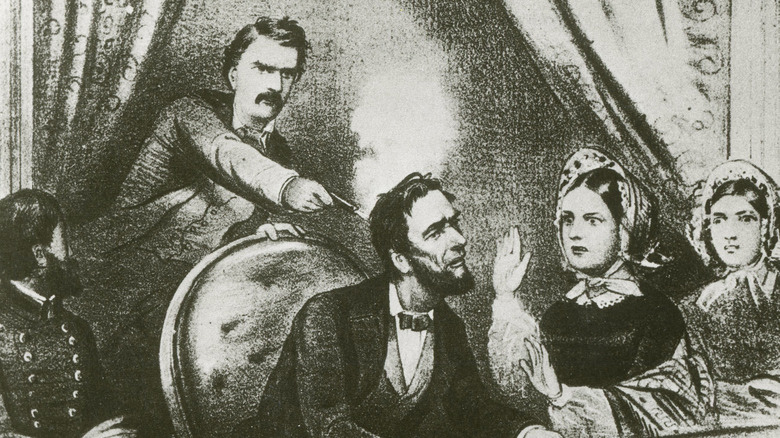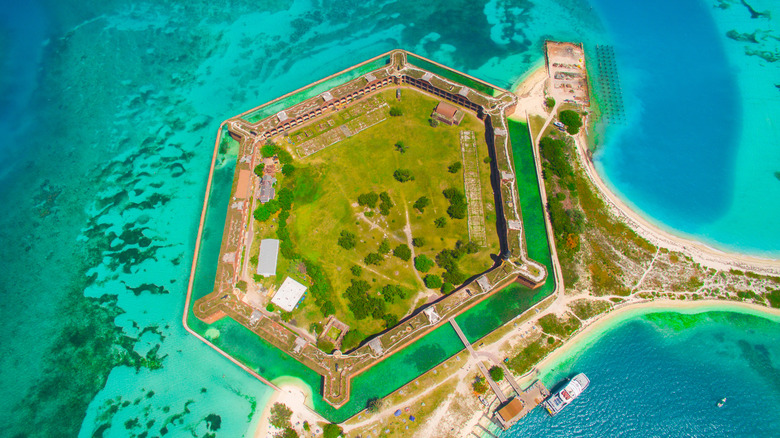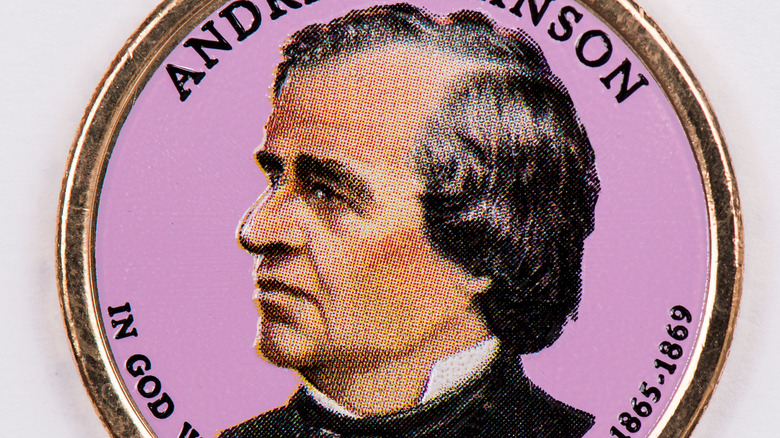How A Lincoln Assassination Co-Conspirator Wound Up Saving Dozens Of Lives In Prison
Anyone who can recall elementary school history classes could probably name the man who assassinated President Abraham Lincoln in 1865. Indeed, the name John Wilkes Booth remains in infamy over 150 years after his dastardly act. What many might not know is that there were many others involved in the plot to kill the nation's 16th president. All told, seven men and one woman were put on trial for the assassination plot, and four hung from the gallows for their participation in the crime.
One of the co-conspirators was a physician named Samuel Mudd, and the story of his involvement in the scheme that left a nation in mourning has been hotly contested for generations. Historians have debated the extent of Mudd's participation, and relatives of the respected physician have long since called for his name to be cleared (via Circulating Now).
Mudd's story involves a chance meeting with the assassin Booth, his life sentence on an island prison, and how he was able to use his medical knowledge to save lives while he was incarcerated.
Dr. Samuel Mudd and John Wilkes Booth
Early in the morning of April 15, 1865, Dr. Samuel Mudd was awakened by two men who arrived at his family's farm. One of the men had a broken leg, which he claimed to have received after falling off of a horse (via Famous Trials). Mudd cut off the man's boot and set the broken leg. He then offered the travelers a place to stay for the rest of the night.
When Mudd was arrested and charged as a co-conspirator, he claimed in court that he didn't know the man with the broken leg was John Wilkes Booth — he was simply giving medical attention to someone who desperately needed it. The physician claimed to not know who Booth was or that he was involved in a plot to assassinate Lincoln.
Prosecutors claimed that Mudd had numerous encounters with Booth and hatched a plot to kidnap Lincoln in November 1864. They also maintained that Mudd had helped Booth plan the safest route off the farm and through the state of Maryland. Both sides presented strong cases in the trial. But in a court of law, only one side prevails in the end.
A narrow escape from the gallows
The jury found Dr. Samuel Mudd guilty of conspiracy (via Circulating Now). Now it was a matter of his punishment. By a single vote, Mudd's life was spared. Instead of facing the gallows, Mudd and three other convicted coconspirators would be serving a life sentence on the Fort Jefferson island prison, 70 miles off the coast of Key West, Florida.
Mudd wasn't one to wait out life in prison. Shortly after arriving at his new home, he wasted no time trying to escape by sneaking aboard an outbound ship (via National Park Service). But his escape attempt was in vain, and it cost him dearly — Mudd was shackled and placed into what would be considered a dungeon. He was held there until January of 1866 when he was returned to the general population (via Lincoln Conspirators).
Following his stint in the dungeon, Mudd was allowed to work in the carpentry shop on the island prison. Little did he know then that fate was about to allow him to show his worth and pave his way to freedom.
The hero of Fort Jefferson
The first case of yellow fever was diagnosed on the island on August 18, 1867 (via Smithsonian). Three days later, the cases had grown to four. With hundreds of military personnel and more than 50 inmates on the island, it was a legitimate concern that this disease could spread in such tight quarters, and spread it did. Before the disease had run its course, nearly all 387 inhabitants had become infected.
Shortly into the crisis, the island's lone physician, Joseph Sim Smith, succumbed to the disease. Samuel Mudd volunteered to run the hospital at the Fort and was immediately granted that responsibility. Mudd set to work getting the infected to purge and sweat the fever out. He prescribed calomel, a mercury-based substance, to aid in his efforts. He also insisted that patients need to stay hydrated throughout this process and made them drink herbal tea.
Mudd was also a stickler about hygiene. When a patient died from yellow fever, staff were placing a new patient in the same bed using the same bedding. Mudd believed, correctly, that this would worsen the conditions. As such, he made it a policy to have clean linens and for the patients being treated to have theirs changed regularly.
By the time the epidemic was over, only 38 patients — or 14 percent of the infected — died from yellow fever. This was a historically amazing feat, as yellow fever could have taken the lives of everyone on the island.
A free man at last
The soldiers and officers on the island were eternally grateful for Samuel Mudd saving their lives. One officer, Lieutenant Edmund L. Zalinski, wrote a letter to President Andrew Johnson requesting that Mudd be granted clemency from the United States government (via Smithsonian). Two-hundred-ninety-nine fellow officers and soldiers signed the request before Zalinski sent it to Mudd's wife, Sarah.
Their efforts did not go unrecognized. Sarah Mudd circulated the letter around Washington, D.C., before presenting it to President Johnson. Johnson signed the doctor's pardon on February 8, 1869, a month before he was scheduled to vacate his office. Now a free man, Mudd resumed his medical practice and worked to bring his family farm back to viability. There, he lived until January of 1883, when he succumbed to pneumonia at the age of 49 (via Circulating Now).




